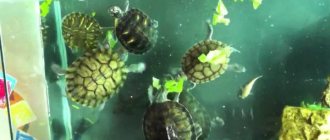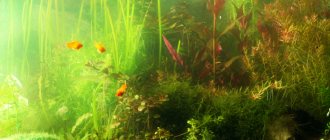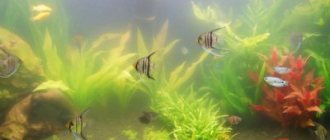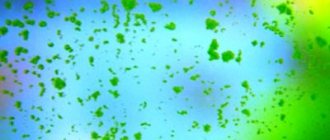Even inexperienced aquarists know that if the water in the aquarium turns green, this is a signal of trouble. Such a nuisance can be caused by various factors and negatively affect the health and life expectancy of the inhabitants of the aquatic environment. For this reason, every person whose home is decorated with a “living corner” needs to know how to deal with the bloom of a pond. Those for whom aquarium keeping is a long-time hobby or a means of earning money know for sure that blooming water is not always considered an indicator of poor care of the contents of the tank and its untimely cleaning; sometimes a greenish tint appears almost immediately after replacing the liquid. There are a huge number of reasons for this phenomenon, and before deciding how to deal with the scourge at home, you will need to find out why the water in the aquarium turns green.
Main reasons: why the water in the aquarium turns green
There can be many reasons for greening, and they are usually due to the inexperience of aquarists.
Euglena green
The name of these single-celled algae speaks for itself and is very familiar to people who have been breeding ornamental fish for a long time. Euglena forms a thin film on the water surface and is an important link in the food chain.
With poor lighting, the green body of euglena becomes discolored: the alga noticeably turns pale or completely loses color . Mass reproduction, leading to increased algal blooms, occurs when:
- intense lighting;
- excess of organic components in water;
- malfunction of aquarium filters.
The flowering of euglena can be very violent: just yesterday the water was absolutely clear, but today it has acquired a cloudy green hue.
Other factors
Provocateurs of greening of aquarium water are also considered:
- unreasonably frequent maintenance of the container (cleaning, renewal/aeration of water);
- poor aquarium maintenance (no compressor, insufficient aeration, rotten water);
- increased water temperature;
- a huge number of planted plants;
- accumulation of chemicals (organic substances) in water;
- incorrect lighting mode (more than 10-12 hours a day) or direct sunlight directed at the aquarium.
Important! Beginning lovers of ornamental fish make another common mistake: feeding them without taking into account natural needs. The fish do not have time to completely eat the food and it sinks to the bottom, where it rots, contributing to the greening of the water.
What is the reason for flowering, what can it lead to?
Any aquarist has at least once encountered water blooms in a fish tank.
Initially, the aquatic environment becomes slightly cloudy, and after a while it becomes green. This process develops spontaneously.
What does this come from? And the reason for this is phototrophic microorganisms (in particular, euglena and chlorella) , which receive nutrition as a result of photosynthesis.
Such organisms are constantly present in the water of the aquarium, but are invisible when the environment is favorable.
But when conditions arise that provoke their activation, they begin to multiply intensively. As a result, a greenish cloud appears. In fact, blooming water does not adversely affect the health of the inhabitants of the aquarium .
However, its aesthetic appearance deteriorates. You should not ignore the problem that has arisen, since green water is a signal of an imbalance. If appropriate measures are not taken in time, it will be more difficult to correct the situation in the future. And this will harm the fish.
They become lethargic and stop taking food. As a result, they are at risk of bacterial diseases. Along with this, vegetation begins to die.
What to do if the water turns green
You can return water to a transparency that is pleasing to the eye in a variety of ways, including resorting to the help of natural cleaners.
Natural cleansing
Introduce so many live daphnia into the aquarium that the fish cannot eat them right away. These planktonic crustaceans can easily cope with excess unicellular algae that have proliferated in the “fish house” . Place “tenants” in it, whose main food is algae: fish (catfish, mollies, platies) and snails.
Look for bladderwort and hornwort (aquarium plants), which, due to their accelerated growth, absorb excess nitrogen accumulated in the water (a catalyst for flowering). Thus, a hornwort can stretch 1.5 meters in a week. First remove the humus from the bottom, replace 1/2 of the water and only then place the plants in the aquarium.
Mechanical cleaning
First, check the operation of the aquarium equipment to make sure there are no problems. It may be worth purchasing additional devices for water clarification, such as:
- UV sterilizer that regulates the growth of algae with directed ultraviolet rays;
- diatomaceous earth filter - thanks to a special filter composition, it retains contaminants and suspended elements measured in microns.
Mechanical cleaning methods can be combined/interspersed with chemical methods.
Chemical cleaning
The operation of the aquarium filter will become more productive if you add activated carbon (in granules) to it. In the process of getting rid of green water, the filter itself is cleaned 1-2 times a week.
This is interesting! Another proven remedy is powdered (crushed) streptomycin, diluted in water. 3 ml of solution per liter of aquarium water is sufficient. This dosage does not affect the fish, but it fights well against the growth of unicellular algae.
It wouldn’t hurt to acquire the Hyacinth coagulant, which was created for drinking water purification, but is also extremely useful in aquarium farming. On the manufacturer’s website it costs 55 hryvnia, which corresponds to 117 Russian rubles. The drug has been tested in action. It turned out that its active formula is capable of neutralizing both organic and inorganic harmful impurities.
Why is green water dangerous for underwater inhabitants and plants?
Let us immediately note that cloudy water does not pose any particular danger to fish and plants. However, as the amount of algae increases, they take away nutrients from the inhabitants of the aquarium, which leads to an imbalance in the aquatic environment.
If the composition of the water changes and the number of plants decreases, the amount of oxygen in the aquarium will decrease. If this negative factor is not eliminated, sooner or later it will affect the development of fish: some will first get sick, while others will immediately die.
Another reason to prevent water from blooming is the unaesthetic appearance of the aquarium. It will be simply impossible to examine its inhabitants, as well as its decor, in muddy water.
What to do with the inhabitants of the aquarium
Please note that deterioration of the biobalance of the aquatic environment has a bad effect on the health of all aquarium guests.
Manipulations for water purification must be accompanied by parallel measures:
- if the fish are healthy, temporarily move them to other containers with a similar water composition;
- place the plants in temporary containers, stirring methylene blue in water (dosage according to the instructions);
- if necessary, replace the old soil with a new one (pre-treated for parasites);
- discard the old water, fill the aquarium with water with the addition of baking soda (1-2 tsp) and leave for a day;
- scald/boil all artificial decorations, including grottoes, driftwood and shells.
If the fight against greening is not radical and the fish remain in the aquarium, only a third of the water is usually changed to fresh.
What causes rapid greening and how does it differ from gradual greening?
Gradual greening is a consequence of problems in the aquarium. It is provoked by the accumulation of a large number of organic elements.
The water changes color due to certain types of algae that are found in absolutely any aquarium. It’s just that in a healthy tank they are not allowed to develop higher plants; they lack nutrition.
But sudden greening is also possible, which turns the water the color of a swamp within just a few hours. This happens most often in the summer, when aquarists use tap water during water changes, and with it these same algae, which grow well in natural reservoirs.
Remedy for green water in aquarium
When regular cleaning and changing the lighting do not improve the situation in the aquarium, liquids and tablets based on substances that inhibit the growth of bacteria and algae on the surface of the water are used. Manufacturers of such products know what to do if the water in the aquarium quickly turns green: they add humic substances to all preparations, which naturally combat film and turbidity. They can be identified by the presence of such components as:
- monolinuron;
- algizite;
- copper sulfate.
Provoking factors
Factors that provoke the violent growth of green algae:
Contaminated soil .
Dirt that accumulates at the bottom over time creates a pathogenic environment for putrefactive formations and the acidity in the water increases. Local inhabitants can no longer cope with cleaning on their own, and the water becomes cloudy.- Foreign substances in water . This means various inclusions: food residues, fish excrement, decaying leaves of plants and shrimp shells. Excess waste creates conditions for the development of microscopic algae, and the level of toxic substances (ammonia and nitrates) in the water increases. This is what phytoplankton feed on.
- Unsuitable place to install an aquarium .
The degree of illumination of the aquarium depends on this. The more intense it is, the more actively euglena algae reproduce. When the duration of daylight exceeds 12 hours, we can soon expect water blooms. Therefore, it is impossible to place a tank with fish near a window, and it is also unacceptable to install high-power lamps. It should be located no closer than 2 meters to the light source, and the recommended spectrum of artificial lighting is 22 Lm per liter of water volume. - Rarely performed filtration . With infrequent water filtration, polluting particles accumulate in large quantities over time. They serve as a breeding ground for single-celled microorganisms. Cleaning must be done at least once every 2 weeks. And also change the sponges in the device at least once a year.
- Incorrect use of chemicals. funds _ Abuse of chemicals, as well as their use not according to instructions, leads to a quantitative imbalance of microorganisms.
- Increased water temperature .
If the water temperature in the aquarium is more than 27 ° C, this leads to cloudiness. It is important to measure the temperature daily and maintain it within 25-27 °C. To solve the problem, you need to move the tank away from the heat source or remove inappropriate artificial lighting lamps (halogen, incandescent lamps) with fluorescent or LED ones. You can use a fan for cooling. - Changing water too often . This leads to the active development of blue-green algae. To avoid this, it is enough to change the water 2 times a month. Just do not do a complete replacement, but a partial one - 30% of the total volume. It is preferable to keep the water at room temperature for about a day before doing this.
- Lack of oxygen .
When the aquarium is overfilled with vegetation, especially in winter with reduced daylight hours, insufficient oxygen production occurs. This is because plants only release it in good light. In return, they synthesize carbon dioxide, which feeds green algae and stimulates their growth. To eliminate the problem, weed and plant mainly plants with slow growth.
Preventive actions
After cleaning using one of the listed methods, you will need to take preventive measures to maintain a normal microclimate in the aquarium. This is necessary to prevent the water from blooming. This is not difficult to achieve; it is enough to follow simple recommendations: install the container so that it is not exposed to direct sunlight; when laying the soil, place the contents at an angle, placing a denser layer of pebbles towards the front wall of the tank; adjust the backlight power at the rate of 0.5 W per 1 liter of content; periodically turn off the lighting, and algae will not grow as actively (many types of underwater plants can do without artificial light for 5-7 days in a row); cover the tank with a lid to prevent particles of dust, insects and debris from entering the water; control the operation of aquarium equipment; Regularly clean the container, decorative elements and replace the water.
These steps do not eliminate the need to periodically replace the contents of the aquarium, but they will help curb bacterial growth and prevent the water from becoming cloudy and green too quickly. Like any pets, fish require proper care and maintenance of cleanliness in their habitats. The peculiarity of underwater inhabitants is that they spend their entire lives in one container, and for their comfortable existence you will need to carefully monitor the microclimate of the underwater world. Otherwise, the inhabitants of the artificial reservoir will get sick and die prematurely.
Prevention
Timely checking of the aquarium equipment, the availability of the necessary devices and regular care of them will prevent the appearance of green water. In the periods between cleaning the tank, you should not overfeed its inhabitants in order to maintain the balance of organic matter at a stable level. Give food in such an amount that the fish eat it in 1-3 minutes.
If the water turns green, it is necessary to create unfavorable conditions for further plant growth: reduce the intensity of lighting and its duration, set the temperature inside the tank at the extreme level of the permissible level for specific representatives. You can deprive the aquarium of light for a week by covering it with a dark cloth. Such measures contribute to the gradual death of plants.
It is important to remember that in moderation, green algae is an integral part of the proper functioning of a closed artificial system, and their excess sometimes leads to disastrous results. If you liked the article, leave comments and share a link to it on social networks.
Proper aquarium care
Professionals in this field know that Euglena viridis reproduces systematically. To do this, you should monitor the level of nitrogen in the water when you first start up the equipment.
Attention! If you have an old aquarium, it is better to take water and cleaning equipment from there. Shortened daylight hours (up to 2 hours per 24 hours, over 30 days) will help regulate nitrogen levels.
With constant monitoring of the devices, the aquarium will be fine. If the aquarium is blooming, it is recommended to check the fish feeding schedule.
Signs
Signs of ecosystem disturbance:
- cloudiness of water;
- change in color of the liquid to green and brown;
- the scenery, water surface and soil are covered with a green film or coating;
- increased content of phosphorus and nitrates;
- abundant appearance of green plaque in the aquarium.
Plaque in small quantities is considered normal. Don't be alarmed if you notice a few green dots in your aquarium. Observe the flora; if the glass becomes more green and the water becomes cloudy, this should be a cause for concern.











